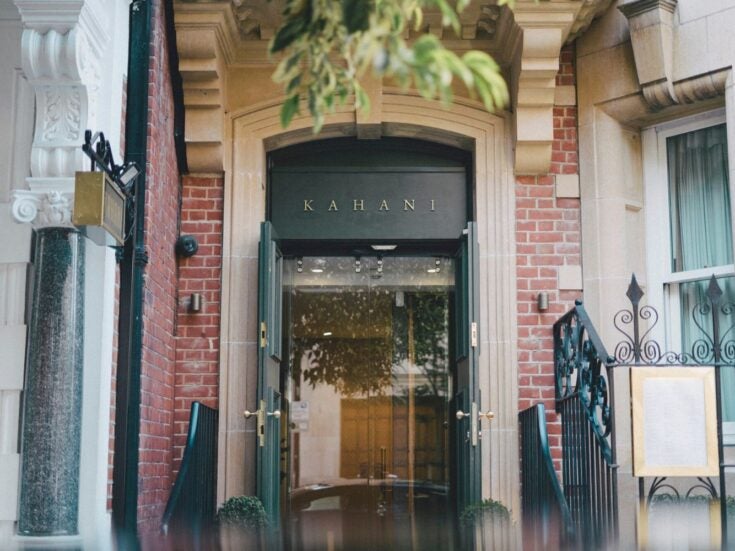
‘Howls of discontent went up from the boxes, where the wealthiest onlookers sat. Immediately, the aesthetes in the balconies and the standing room howled back… The literary hostess Jeanne Mühlfeld, not to be outmaneuvered, exploded into contemptuous laughter. Little more of the score was heard after that.’ So writes Alex Ross of the May 1913 premiere in Paris of Stravinsky’s Rite of Spring (watch this below), that hyper-rhythmical, eternally unfamiliar shock to the senses, made all the more violent that night with Nijinsky’s choreography of ‘near-anarchy’. While Ross points out that the piece was soon acclaimed, acclamation came only after insurrection.
Such a tumult was not an unfamiliar scene (‘the bedlam on the avenue Montaigne was a typical Parisian affair’), and indeed arts-loving Parisians of 1913 found their senses and tastes assailed frequently by the bold strikes figures like Picasso, Matisse, Diaghilev, Apollinaire and Proust were making as they smashed down pristine propriety and erected crooked barricades of the new, the ugly, the shocking.
Not that shock value was the (whole) aim of their art, but shock value much of it had: it was, I would contend, easier to shock the public with words, paint and dance steps then than it is today. For Picasso to try and cram three dimensions onto a flat canvas with Demoiselles d’Avignon or Apollinaire to mix holy imagery with urban malaise was genuinely revolutionary. For us, who live in a world where the arts have encompassed and assimilated things Leonardo could never have imagined (Manzoni’s cans, some of Warhol’s videos, Sarah Kane’s Blasted), nothing in art can truly shock us. Or can it?
And up the road…
The Rite of Spring was not the only notable opening on the avenue Montaigne in 1913. A little way up the broad, shady street, set back by enough room for a terrace, was a hotel which provoked no riot. Installed in Haussmann’s townhouses, the Plaza Athénée soon attracted Stravinsky’s catcallers and jeerers in their more civilised moods, and later artistic types like Josephine Baker, Rudolph Valentino and Maurice Chevalier.

In April, a friend and I checked into the Plaza Athénée as it celebrated its centenary, just ahead of the Rite’s. (The hotel co-opted the piece into its plans with an exclusive ‘Rite of Spring’ offer, from €2,900.) First, an unrequested rollaway bed had to be removed from our room; the thought crossed my mind that two men sharing a double bed might not be quite the thing on the avenue Montaigne, but I was reassured it was because my friend’s surname was Child and the hotel had mistaken that for an indication of his age. Make of that what you will.
We joined a party of journalists for lunch on the terrace and one of the charms of the hotel became instantly clear: sitting behind a head-height hedge, you become an object of fascination for those strolling by (mainly Saint Etienne football club fans that afternoon). The hotel should list ‘mystique enhancement’ as one of its complimentary services.
The craned-at quickly became the craners as we squeezed and squinted to see whom the management of the hotel were greeting outside the main entrance. A paparazzo lurked. Was it Beckham? It could be Beckham? Was it Beckham? It wasn’t Beckham. It was, in fact, favoured guests of the hotel, who proceeded past two polished rows of staff arrayed in the lobby, an odd guard of honour, into the public spaces of the hotel, to await the centenary tea party.
Cake walk
You could not miss the centenary tea party, not least as a thirty-foot high wedding cake dominated the hotel’s courtyard (pictured below, with journalists in front). Jazzy tunes and cocktail chatter floated around the courtyard, filtering through the open windows with their bright red awnings, and champagne and delicacies (as much as crêpes can be delicate) were handed out to the guests. A lady who seemed to have been dressed by Vivienne Westwood and a box of highlighter pens was apparently Paris’ most senior head-hunter.

After a fanfare of the Sex and the City theme tune (some of the final two episodes had been filmed at the Plaza Athénée), dignitaries including Brunei’s ambassador to Paris (the Dorchester Collection is owned by Brunei) and Alain Ducasse, whose restaurant at the Plaza Athénée has three Michelin stars, proceded onto a daïs to place items into a time capsule, to be opened in 25 years’ time. In a much shorter period, three adjacent buildings, we were also told, were being incorporated into the hotel.
At one point, the hotel manager presiding over the compilation announced that Monsieur Alain Delon would be putting something into the chest. A red-faced figure staggered from behind me and made his way onto the stage; if this had ever been the beauty of Plein Soleil, it was not obvious as he swayed on stage and looked with cheerful amour at the pretty blonde descendants of the hotel’s original owner.
Before the cake was cut – small, real cakes, rather than the towering polystyrene wedding-cake, with its silver-sprayed putti – there was a countdown and a hundred balloons in the Plaza Athénée’s red were released. The (non-shocking) jazz resumed.
Tuning forks
Dinner was in Le Relais Plaza, the hotel’s non-Ducasse restaurant, where restaurant manager Werner Kuchler was swinging. A crooner, a would-be Sinatra, he led a jazz trio in English and French standards while we ate our second round of Brittany lobster that day (that is in no way a complaint). Veal, asparagus and moreish morel mushrooms followed, then a refreshing fruit melba.
Buoyed by champagne (as if it can do anything other than buoy), our table started to sing backing for Werner as he moved around the restaurant, serenading the elderly gentlemen and the immobile, oddly-angled faces of their wives. Our singing got louder and apparently catchier, as other diners joined in. I said that art couldn’t shock, but a roomful of Parisians and Parisian guests lustily, not wholly tunefully, singing La Vie En Rose at full throat can probably still stun.

Pictured above: Alain Ducasse at the Plaza Athénée
We tumbled out of Le Relais Plaza into La Galerie des Gobelins, an arcade which usually serves afternoon tea, but which tonight had had a small stage set up for some shimmying singers in the tradition of Josephine Baker. The activity was listless until much later, when la belle Paris in its finest couture turned up, took off its coat and picked up its champagne flute.
Fashion bloggers and lawyers, socialites and models promenaded along La Galerie. A Russian lady complimented on her barely-there Balmain dress gave a detailed explanation of its origins. Everything sparkled. Everyone sparkled.
People sparkled a little less as the evening wore on, waiting for the bar and its dance floor to open. Even though the evening had clearly begun – the champagne, the singing, the further champagne – knowing that there was a door yet to be opened created an unwelcome anticipation. You had the feeling that you could be enjoying yourself more in the next room, only the next room was closed. It’s a kind of party greed.
What makes party greed worse is when it’s justified – when the next room is indeed more fun than the current one. The double doors to the bar were pulled back to reveal to revelers a man on a very tall ladder, precisely pouring a bottle of champagne down a tower of flutes twelve levels high. The champagne filled then overfilled glass after glass, trickling down from layer to layer, and bottle after bottle was marched up and down the ladder. I have seen this before, but, perhaps magnetised by the champagne inside me, I found it a lot more entertaining this tim. We began to dance.
Sunny side up
The next morning, the sun doing wonders for my sore head, I walked up the avenue Montaigne, turned right onto the Champs-Élysées, headed past the horses waiting in the dust for their tourist-riders, through the already-crowded Tuileries and out the other side, in search of art that today could still shock.
Entering the Denon wing of the Louvre, you lose most of the crowds heading for the Mona Lisa pretty quickly. (If someone could tell me what it is about that blasted painting that is so interesting – more interesting than the acute Titian portraits which hang on the rear of its wall, say – please let me know.) A sharp left and you’re in the most shocking room in Paris.
The roof (from above) looks like a giant has dropped a golden handkerchief into the Louvre’s Visconti Courtyard and it has stopped mid-fall, curving and rippling and seemingly weightless. It is in sharp contrast to the neo-classical buildings arrayed each side of the courtyard and neatly encapsulates the difference between the manifold, flexible Islamic arts within the courtyard and the austere Western Old Masters on the levels above.

For this is the Louvre’s new Islamic gallery, opened late last year, costing $125 million and the most revelatory museum space I have experienced since the Ashmolean in Oxford tore out its walls and juggled its collection to erase time and space.
Watch videos of how the Islamic galleries were designed and built
Work by work
The collection runs across every art form from calligraphy, carving and ceramics to metalwork (bowls, lamps, armour), glasswork and textiles; across every country from Spain to India; and across every century from the seventh to the nineteenth. Drawn from the Louvre’s 14,000 items, with 3,500 added by the Musée des Art Décoratifs, the span is simply astounding, confounding narrow ideas about what Islamic art was.
Individual pieces stun. Take a crystal ewer made in Egypt a thousand years ago, a refined item shaped from a single rock. Another immense technical achievement is the candlestick with ducks. (No, it’s not as cheesy or Home Counties as it sounds.) It looks like a large, elaborately decorated bell with a sconce instead of a curved top, and all around it are tiny, proud ducks. This entire work is one piece of metal. Nothing has been added. The ducks, the bulges and all the figures have been beaten out from one sheet of metal. I can’t even fold a Kit Kat’s silver foil neatly.

Wood items are normally the worst survivors among historical artefacts – when a city was sacked and burnt (as most have been at some point), wood goes up first. It also rots in the wrong conditions and is relatively fragile, so to find so many beautiful carvings here is a wonder. Many bear Arabic tags from the Quran in what we might call different ‘fonts’, mixing meaning and form, stretching and compressing letters for beauty’s sake.
Watch videos of highlights of the Islamic galleries
The courtyard is small but well-filled, with row after row of display cases arranged at jaunty angles. (Sometimes a little too jaunty, as it’s hard to follow the order.) As I crossed the floor, I noticed a staircase heading downstairs, and was halfway down when I looked to the right and became instantly dumbstruck: as well as the modest courtyard, there is a further gallery stretching under the Louvre’s existing buildings, taking the space devoted to Islamic art to over 32,000 square feet. The revelation of the full extent of the physical gallery is the perfect metaphor for how visitors come to understand what Islamic art truly is.
There are more wonderful things down here than I can describe – vases influenced by interchange with China, full suits of armour, enormous mosaic floors, the painstakingly restored Mamluk Porch, and if the two gallery attendants I saw wrestling with a gushing tap have not flooded the space beyond repair, I recommend you take in all of them, for your eyes to experience today the magnitude of the shock that the ears of Stravinsky’s audience did a century ago.
Watch The Rite of Spring by Stravinsky
Read more on Paris from Spear’s
Don’t miss out on the best of Spear’s articles – sign up to the Spear’s weekly newsletter
[related_companies]





